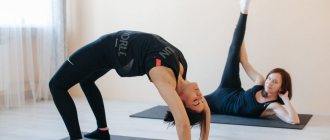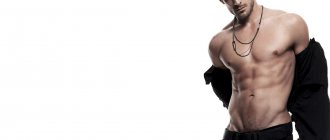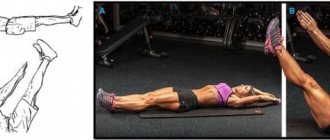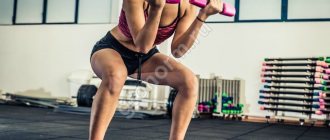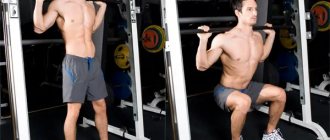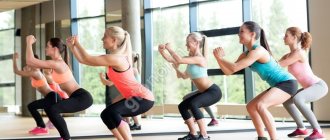Benefits and disadvantages of Bulgarian squats
An obvious advantage of split lunges is that this type of exercise is physically and technically difficult. Firstly, due to the elevation of the auxiliary leg, you need to maintain balance, and secondly, due to the lack of help from additional muscles. In this position, the athlete is deprived of the opportunity to help with the second leg.
This type of lunge uses the maximum number of muscles, compared to other lunge options, due to the position of the second leg, making it impossible to distribute the load.
The disadvantage of the exercise can be considered the technical difficulty of execution. Finding a comfortable position to perform the movement and maintaining balance is extremely difficult, which can lead to falls and injuries.
A person may also experience discomfort in the ligaments. People with ankle or foot injuries may find it impossible to perform this exercise due to severe discomfort or pain in the ligaments.
Necessary equipment
The classic version of the exercise is performed with a barbell and a bench on which you can place your foot.
However, this exercise can also be performed with dumbbells. If you're using dumbbells, you have two options. The first is to hold each dumbbell over your shoulders, just like in the starting position for the military press. This way we simulate the weight distribution for a Bulgarian barbell squat. Another way is to stretch your arms with dumbbells along your body while squatting.
Each option has its pros and cons.
The positive aspect of arms extended along the body is that they are also used during the exercise. However, the advantage of holding dumbbells at your shoulders is that the weight is placed directly over the spine and pelvis, which puts more stress on the target muscles. Since the exercise involves working the lower body, if using dumbbells the ideal option would be to place the weight closer to the shoulders, but it's up to you (Men's Fitness, 2017).
In addition to barbells and dumbbells, you can also use a kettlebell. You may find it easier to hold this projectile.
Just like choosing a position for where to hold the dumbbells or whether to use a barbell at all, it's a matter of personal preference and comfort.
As the load increases, however, you will most likely decide to turn to dumbbells or a weighted barbell, since you may not find the right weight of weights.
What muscles work in Bulgarian split squats?
When performing Bulgarian lunges, the following muscles are involved:
- Quadriceps.
- Gluteal muscles.
- Thigh biceps.
- Adductor muscles.
The stabilizing muscles are the spinal extensors and abdominal muscles.
What muscles are pumped when doing the exercise?
This exercise works the lower body, but which specific muscle groups does it target?
Ultimately, if you're someone who works different areas of your lower body on different days, you need to know this. When performing the movement, you especially use the gluteus maximus and quadriceps muscles. You also engage the soleus and pectineus muscles. In addition to all this, you engage a large complex of movement-stabilizing muscles, including the gluteus medius and minimus, plus tendons and gastrocnemius.
The gluteus maximus muscle determines the shape of the buttock and is the largest muscle in the pelvic region.
Other muscles of the pelvic region, namely the gluteus medius and minimus, run along the femur and act as stabilizers. Another large muscle group used by the Bulgarian split squat is the quadriceps, which is located on the front of the legs from the hip to the kneecap.
Minor muscles involved in the movement include the soleus and gastrocnemius.
These muscles run along the sides of the thighs and include a section of tendon, while the rest of the tendon functions as a stabilizer. Overall, the Bulgarian split squat works almost every muscle in the lower body in one way or another.
Bulgarian lunge technique with dumbbells
- Stand at a short distance with your back from the bench, take dumbbells in your hands.
- Place one leg back on a hill, the knee of the back leg should not be straight.
- The supporting foot should be under the knee. Hands with dumbbells are freely lowered along the sides of the body.
- As you inhale, the pelvis goes down, the knees bend. The knee of the supporting leg should not extend forward beyond the toe.
- Exhale and straighten your supporting leg.
- At the end of the set, remove the foot of the back leg from the hill and change position to the other side.
Common mistakes
Rear leg pointing directly behind the front leg
If you place your back foot directly behind your front foot, it will be almost impossible to balance your body during the squat. Since the front leg is doing all the work, the body is already in a state of imbalance. Your torso muscles are already working to maintain balance as you move up and down. And if you reduce the area from which you perform the exercise (by placing your feet directly in front of each other), it becomes almost impossible to perform the exercise.
When you place your back foot on the bench behind you, make sure that the distance between your legs is the same as between your thighs, if not wider. Although the muscles in the back leg do not do much of the work, they serve to maintain balance and stability. This stability will allow you to perform these squats correctly.
Bend forward from the hips when squatting
When performing squats, there is often a temptation to give the torso muscles a rest - after all, both the back and abdominal muscles get tired when squats. This is especially noticeable when lowering. But bending forward not only limits the benefits your abdominal muscles receive from the exercise, it also places even more stress on your knees, moving the weight further forward.
Also, if you are used to performing lunges from a bench, bending your torso forward. Then you will almost certainly get injured when you add the barbell. Before you begin the downward movement, engage your abdominal muscles and move your shoulders back. Try to maintain this correct posture throughout all repetitions of the exercise.
Lifting onto your toes while squatting
This bad habit appears in those who already have problems with correct technique. The person tries to compensate and to do this he stands on his toes as he squats. This usually indicates one of two problems: first, your front leg is too close to the bench and it's time for you to move it forward to maintain proper balance and posture. Or two, you bend forward at the hips when you squat, and you have to rise onto your toes to maintain balance because the weight is concentrated in front.
If you notice that you have to stand on your toes while doing the exercise, stop and start again. Check the placement of your front leg—you may need to move it further forward—and make sure your torso doesn't lean forward as you lower.
Performing work with the back leg
Remember that the trick of the movement is that only one leg does the work. Although the back leg helps by maintaining balance, it should not be used during the exercise. At all times, you should be able to lift and move your back leg to ensure that it is not pushing the body, not supporting the weight, but just balancing.
The front knee is not over the toe of the front foot
When performing any variation of squats or lunges, we must ensure that the front knee is always over the toe. It should not move either inward or outward, as this places additional stress on the knee, especially if the exercise is performed with one leg, when the weight of the whole body is supported on this knee.
Make sure your front knee is always over your toe, especially as you transition between the down and up phases of the movement.
Bulgarian lunge technique in Smith
Bulgarian lunges in the Smith machine allow you to focus on one or another muscle group.
- To train the front of the thigh, the foot should be placed strictly under the bar. Moreover, the load will be focused directly on the teardrop-shaped bundle of the quadriceps. The elevation for the auxiliary leg should be installed approximately half a meter from the machine.
- To effectively work the gluteal muscles, the front (working) leg should be placed as far as possible, and the bench closer to the bar. This way the amplitude of movement will be much shorter, the distance between the legs will also be shorter, but this will create a maximum load on the gluteal muscles, they will be in tension all the time. Naturally, when performing this exercise you will not be able to maintain your posture, since you will have to shift your body towards the bar.
Should you perform Bulgarian lunges in Smith in such a way that the knee angle is too sharp and the body is tilted?
Of course, this is not the best option for training legs. There are many more excellent machines and exercises in the gym, thanks to which the athlete will simply achieve results in the development of leg muscles.
Read more about leg exercises in the gym → Leg exercises in the gym for girls →
Interesting points
To ensure that your training brings the desired results, pay attention to the following subtleties when performing Bulgarian lunges:
- During squats on your working leg, keep your shin strictly vertical, your knee and toe pointing forward. In this exercise, the anatomical position of the joints is extremely important.
- Balancing with dumbbells is much easier than with a barbell. The load on the spine is also less. You can work with a barbell in a Smith machine, but in other cases you should prefer doing it with dumbbells.
- Use small, or at least medium, weights. When learning the technique, you can generally do without weights or use small dumbbells.
- If your goal is overall leg mass, opt for classic squats and lunges. Use Bulgarian lunges to give your legs and buttocks the ideal shape and texture.
- Keep your back straight, do not lean forward.
By incorporating the Bulgarian-style split squat into your workouts, you can effectively work your legs and butt muscles and give your lower body a beautifully defined shape. Listen to your feelings, get enough rest and make your workouts more productive every day.
Barbell Split Squat Technique
- Take a position in front of a bench with a barbell on your shoulders, with your back to it.
- The height of a bench or other elevation should not be much lower than the knee.
- The supporting leg should be placed on the bench.
- When performing the exercise, the athlete must monitor his posture. The back should be in a vertical position.
- The movement begins with a squat. The back leg is only used to maintain balance.
- The athlete will reach the lowest point of amplitude at the moment when the knee joint forms an angle of ninety degrees. During the downward movement, inhale. The movement is performed slowly and smoothly.
- When moving up, exhale. There is no need to fully extend the knee at the top of the movement.
Split squat technique
Despite all its simplicity, the exercise has increased complexity; in order for it to work and bring the desired (and not just any) result, you must strictly follow the instructions on how to do lunges correctly:
With dumbbells/disc in place
So, how to do split squats with dumbbells correctly - execution technique:
- Walk up to a low bench with dumbbells in your hands. Place one leg on the edge of the bench and take a step forward with the other. This “straddle” will be the starting position.
Keep your back straight and look straight ahead.
- Inhale, as you exhale begin to go down , bending the knee and hip of the SUPPORTING leg. As soon as you lower yourself to the parallel of your thighs to the floor or slightly lower, using the force of your leg muscles (with your heel as a support point), push yourself up and return to the starting position (point 1).
Can be performed with dumbbells, barbells, or in a Smith machine.
In Smith
Smith machine lunges are effective for working the hamstrings and glutes. What are its advantages compared to reverse lunges with dumbbells:
The simulator helps relieve stress from the body , making it possible to focus on the core muscles. The fact is that in this case the trajectory of the projectile is fixed, which means that the load on the stabilizer muscles of the body is removed.
The movement begins by moving your butt back. The angle of the standing leg is 90 degrees!
In addition, the Smith machine makes it easier to maintain balance and concentrate on performing the exercise.
Bulgarian lunges in the simulator are done in the same way as usual. With this exercise, you can work out your working leg well and effectively stretch the muscles.
We remind you : the load during the exercise falls on the knee joint of the working leg, so the condition for safe training is a high-quality warm-up and strict adherence to technique. By skipping the warm-up, you risk injuring your knee and getting a sprain. If you already have problems with your knee, you shouldn’t risk it - avoid lunges.
Smith lunge technique:
- Before performing the exercise, you should adjust the weight on the bar as much as possible. Don't be a hero, adequately assess your strengths. The bar should be just below the shoulders.
- Position yourself under the bar with your feet shoulder-width apart. The bar should rest comfortably on the trapezius muscles of the back.
- It is advisable to bend your back slightly in the lumbar region, while you should only look vertically. Take a step so wide that when you lunge, your thigh is parallel to the floor. Take one leg back, placing it on the floor on your toes or on a bench;
- Inhale and lower yourself, exhaling and returning to the starting position.
With a barbell
A very dangerous option! Maintaining balance while performing an exercise with dumbbells is a trillion times easier than with a barbell. Bone Wide against this method of performing Bulgarian backward lunges. Using a barbell (even with the smallest weight) while standing on one leg is very dangerous!
If you just desperately want to perform lunges with a barbell on your shoulders, then there are 2 ways to put the apparatus on your back:
- When performing the exercise, Bulgarian lunges for the buttocks with the support of a trainer who will hand you a barbell. Make sure there is no pain in the cervical region!
- Stand at a distance of about half a meter from the bench (platform, stand), with your back to it. Place a barbell on the floor in front of you. You stand straight, feet shoulder-width apart. Bend your knees and use a straight grip with your hands slightly wider than shoulder width. Then lift the barbell overhead and position it at the base of your neck (traps) . Move one leg back so that the toe of your foot is resting on the flat bench.
A very dangerous option even for experienced ones! It is very likely that you will either drop the barbell or simply not maintain your balance and fall with it on the floor under the puzzled looks of those present.
Cross legs with crossed legs
As you can see from the red lines, the center of your movement, the dough at the beginning, middle and end is the same!
You should not fall to the side or backwards! Cross or oblique lunges are most useful for girls, as they perfectly work the gluteus medius. They are especially loved by gymnasts and other lovers of polishing the center of the Universe.
However, it is very important to know: this exercise is dangerous for the joints! For proper execution and your safety, you must have flexibility in your joints. The range of motion for the knees and ankles is too unnatural.
For the same reason, cross lunges use less weight than classic lunges. In addition, always take less weight - better do more repetitions !
So, first we learn how to perform the exercise diagonal lunges back without weight. And only after you have brought the movement to automaticity, you can take dumbbells/disc/barbell.
- Feet slightly wider than shoulder width and point your toes slightly apart. Your knees should be pointing in the same direction as your toes.
- Shift your weight to one leg and take a long step back with the other, diagonally towards your supporting leg. As a result, you have one leg in front, the toe of its foot is directed outward, the second leg is behind, crosswise, its toe is directed forward or very slightly inward (the knee is in the same direction).
- Squat down, bending the knee of your working leg so that your thigh is parallel to the floor. The knee does not go beyond the toe, and the weight remains on the heel throughout the entire movement. With the knee of your supporting leg, reach towards the floor behind your working leg, but do not touch it. At the bottom of the squat, you should feel a stretch in the gluteal muscles of your working leg.
- Get up.
- Next, you can either repeat squats without changing the position of your legs, or return to the starting position (feet wider than shoulder width) and on the next repetition take a step back with your supporting leg and squat.
The knees should not go to the side - if the foot is directed outward, then the knee “looks” outward, if inward, then inward.
You can make the movement more difficult by doing diagonal lunges in steps (returning the supporting leg to the starting position after each squat) and also adding a side swing. This way you will put additional stress on the gluteus medius muscle.
Or, for example, place your working foot on the step. Move your supporting leg back in accordance with the movement technique. By performing lunges or curtsy squats in this way, you will stretch your buttock as much as possible, which will make the workout even more effective.
According to the recommendations of experts, this exercise is more suitable for athletes with experience . The fact is that the technique of this training is not as simple as it seems at first glance. The difficulty of performing this lies in the fact that not only the muscles of one leg work here, but you also have to try to maintain balance.
Cellulite does not go away when playing sports and losing weight: what to do?
What muscles work?
Are you interested? Let's find out exactly which muscles Bulgarian squats allow you to pump up:
- Quadriceps;
- Gluteal - all;
- Biceps femoris;
- Calf;
- Press;
- Back;
Yes, the same muscles work in classic types of squats, but Bulgarian ones are much more difficult to perform, which means they cope with the assigned task much more effectively.
Benefits, harms and contraindications
Bulgarian split squats with a barbell are very useful for training the muscles of the thighs and buttocks. They develop joint mobility, teach balance, and do not put much strain on the back. They perfectly promote stretching and help achieve the ideal shape of your butt and legs.
However, they also have disadvantages. This is a rather traumatic task, especially for unprepared beginners. If you do not follow the correct technique for performing Bulgarian single-leg squats, you can easily damage your joints, ligaments or tendons, including serious sprains or a torn meniscus.
Who are contraindicated for Bulgarian lunges?
- People with any problems with knee joints;
- People with a sore spine;
- For cardiovascular diseases;
- During colds, during periods of increased body temperature;
- For any exacerbation of chronic diseases;
- For neurological syndromes.
Kettlebell split squats will be more effective if you combine them with classic lunges. They will become a harmonious part of a complex aimed at training the hips and buttocks. We recommend that you carefully study the technique, warm up well before the approaches, and never use weights that are too heavy.
Tips and training program
When performing the Bulgarian squat, it is very important to keep your back straight and chest out.
This will allow you to keep your hips in line with your back, which will protect you from possible injury. This will also help you maintain balance during the exercise. The Bulgarian lunge is done in the same way.
You also need to “sag” in your hips and not fall forward. Leaning forward puts you at risk of knee injury due to the heavy weight being placed on your bent leg. It also reduces the stress on the glutes and quads, which reduces the efficiency of the movement. And finally, the foot with which you press into the ground should be firmly planted.
It may also begin to curl inward, which should also be avoided. Once this starts to happen, the hips will begin to move, which will affect balance and can also lead to injury to the pelvis and lower back - technique is very important.
As for the exercise program, use a barbell or dumbbells that allows you to perform 8 to 12 reps per set. This is for each leg. If you're completely exhausted by the eighth rep, that's okay because you'll increase strength this way, but it reduces your chance of building size. Maximum muscle gains occur when you reach nine or 10 reps per set. (I don’t know why he writes so strangely, the first number in words, the second in numbers. I write like him. - approx. transl.) After completing the approach, switch to the other leg and repeat.
When you first start training, the Bulgarian split squat should be performed twice on each leg. As your legs become accustomed to the movement over the next few weeks, increase the weight and work up to three sets. Due to the fact that the Bulgarian split squat involves a large number of muscle groups, perform it closer to the beginning of the workout.
Working muscles in Bulgarian squats
If we talk about body zones, then the legs work (both, although each in a different way), the muscles of the lower back and the muscles of the lower abdomen.
Front leg: quadriceps - rectus and vastus lateralis muscles (roughly speaking, the two heads of the quadriceps muscle), the biceps femoris, gluteal muscles (minimum, middle and large), adductor muscles of the belly (longus and major) also work, the gastrocnemius also participates a little and soleus muscles,
Posterior leg: gluteal muscles (minimum, medius and maximus), abductor muscles (longus and major), semitendinosus and semimembranosus muscles, vastus medialis (another head of the quadriceps), gastrocnemius and soleus muscles are also involved a little.
To put it simply, the supporting leg (front) works with the front surface of the thigh, and the back leg with the back surface. In this case, the back extensors, lower abs and oblique muscles are evenly involved in the work.
For girls, lunges on one leg are a great opportunity to pump up their buttocks and legs.
Bulgarian type lunges compared to classic ones
If in ordinary lunges the front leg accounts for 55-60% of the load, then in Bulgarian lunges it is 70, or even 80%
The exercises are multi-joint, which is similar to regular lunges. The same muscles are activated. But the entire load is performed on one leg. The other leg (supporting) serves to support and maintain balance.
Targeted training of individual muscle groups gives a good effect. With proper control, the load on each leg is targeted. It can be proportionally increased for the lagging leg. The lack of tilting of the body, unlike the classic version, reduces the load on the spinal column.
Benefits of using Bulgarian lunges:
- improving the balancing functions of the body;
- good conditions for isolating leg muscle groups;
- stimulation of volumes and strength of the lagging leg;
- activation of the development of optimal buttock shapes;
- improving joint stability (hip and knee);
- strengthening small muscles in the legs, core muscles, stabilizers;
- improving the ability to push and jump;
- variability and ease of use at home using a chair or sofa.
Bulgarian lunges are characterized by the suspended state of one of the legs, in contrast to the uniform use of both legs in the usual version. Putting weight on one leg makes the task more difficult. The quadriceps works without pause.
If you compare the exercise with regular squats using a barbell, then in the Bulgarian version the activity of the hamstrings and buttocks is significantly higher. With a barbell, the activity of the quadriceps increases. Testosterone levels rise identically in both cases. It is easier to maintain balance with dumbbells than with a barbell.
Split squats serve more for the formation of relief. Classic lunges are more suitable for increasing the total mass of leg muscles.
